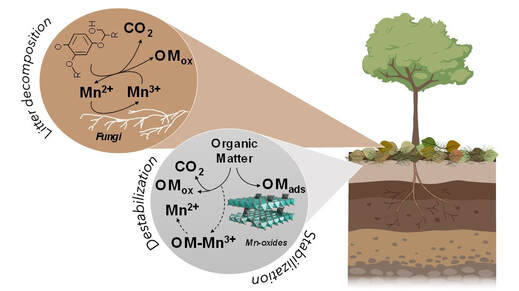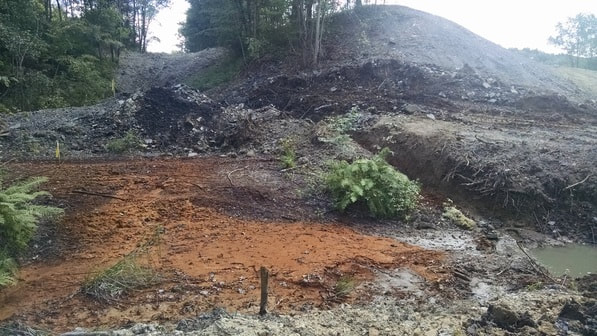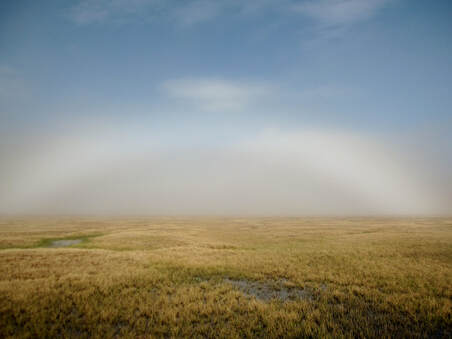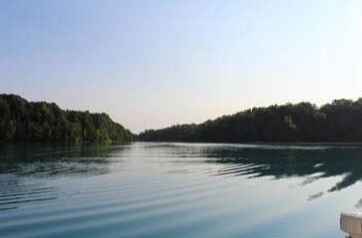Geochemical regulation of ecosystem carbon storage

Elucidating the complex controls on ecosystem carbon storage is critical for predicting how earth systems will adapt to changing climate. Furthermore, managing ecosystems to increase carbon storage may partially offset carbon dioxide emissions and protect future ecosystem sustainability. However, ecosystem representations that focus exclusively on biological components and disregard geochemical processes will fail to accurately represent ecosystem function. This research will advance the understanding of complexity in biological and environmental systems by elucidating a coupled element cycle across multiple scales that has implications for how carbon is sequestered in terrestrial ecosystems. This work aligns with ongoing efforts to translate molecular-scale characterization into ecosystem-scale understanding and predictive models. The two aims of the work are to 1) examine the processes by which elevated Mn may accelerate litter decomposition; and 2) determine the net effect of organo-mineral interactions on C storage.
This project was funded by DOE Oak Ridge National Laboratory Strategic Hire package to Herndon (2019 - 2021)
Related Publications
This project was funded by DOE Oak Ridge National Laboratory Strategic Hire package to Herndon (2019 - 2021)
Related Publications
- Neupane, A., Herndon, E., Whitman, T., Faiia, A., and Jagadamma, S. (2023) Manganese effects on plant residue decomposition and carbon distribution in soil fractions depend on soil nitrogen availability. Soil Biology and Biochemistry. https://doi.org/10.1016/j.soilbio.2023.108964
- Santos, F., and Herndon, E. (2023) Plant-soil relationships influence observed trends between Mn and C across biomes. Global Biogeochemical Cycles 37(1), e2022GB007412. https://doi.org/10.1029/2022GB007412
- Li, H., Reinhart, B., Moller, S., and Herndon, E. (2022) Effects of C:Mn ratios on sorption and oxidative degradation of small organic molecules on Mn-oxides. Environ. Sci. Technol. 57(1), 741-750. https://doi.org/10.1021/acs.est.2c03633
- Li, H., Santos, F., Butler, K., and Herndon, E. (2021) A critical review on the multiple roles of manganese in stabilizing and destabilizing soil organic matter. Environ. Sci. Technol. 55(18), 12136-12152. https://doi.org/10.1021/acs.est.1c00299
- Kruse, S., Rosenfeld, C., and Herndon E. (2021) Manganese uptake by red maples in response to mineral dissolution rates in soil. Biogeochemistry 155, 147-168. https://doi.org/10.1007/s10533-021-00817-4
Huff Run and the legacy of mine waste in Appalachia

Mining for geologic resources has created a legacy of disturbed landscapes and impaired water quality throughout the United States. Acid Mine Drainage (AMD) is prevalent in heavily mined coal basins where the sulfuric acid and toxic metals mobilized from mined rock leach into streams and rivers. Although billions of dollars have been spent over recent decades to reclaim AMD-producing mines and treat discharges to AMD-impacted streams, leaching of acid and metals from refuse piles in abandoned mine lands (AML) pose an ongoing hazard to water quality and ecosystem health. This research, conducted in collaboration with David Singer at Kent State, investigates soil development on coal mine waste and the impact of vegetation on metal mobilization and solute transport at the Huff Run Watershed in eastern Ohio. This work was supported through grants from The Ohio Water Resources Center and Kent State Farris Family Foundation.
Related Publications
Related Publications
- Herndon E., Yarger, B., Frederick, H., and Singer, D. (2019) Iron and manganese biogeochemistry in forested coal mine spoil. Soil Systems 3(1), 13. https://doi.org/10.3390/soilsystems3010013 (open access)
- Shaw, M., Yazbek, L., Singer, D. and Herndon, E., (2020) Seasonal mixing from intermittent flow drives concentration‐discharge (C‐Q) behavior in a stream affected by coal mine drainage. Hydrological Processes. Online Access
- Singer, D.M., Herndon, E., Cole, K., Burkey, M., Morisson, S., Cahill, M. and Bartucci, M.A. (2020) Micron-scale distribution controls metal (loid) release during simulated weathering of a Pennsylvanian coal shale. Geochimica et Cosmochimica Acta, 269, pp.117-135. Online Access
- Singer D., Herndon E., Cole K., Koval J., Perdrial N. (2020) Formation of secondary mineral coatings and the persistence of reduced metal-bearing phases in soils developing on historic coal mine spoil. Applied Geochemistry 121, p. 104711. https://doi.org/10.1016/j.apgeochem.2020.104711
- Yazbek, L., Cole, K., Shedleski, A., Singer, D., and Herndon, E. (2021) Hydrogeochemical processes limiting Fe export in a headwater catchment impaired by acid mine drainage. ACS ES&T Water 1(1), 68 – 78. doi.org/10.1021/acsestwater.0c00002
- Chowdhury, M. A. R., Herndon, E., and Singer, D.† (2021) Colloidal metal transport in soils developing on historic coal mine spoil. Applied Geochemistry 128, 104933. https://doi.org/10.1016/j.apgeochem.2021.104933
- Singer, D. M., Herndon, E., Zemanek, L., Cole, K., Sanda, T.G., Senko, J., and Perdrial, N. (2021) Biogeochemical controls on the potential for long-term contaminant leaching from soils developing on historic coal mine spoil. Soil Systems 5(1), 3. https://doi.org/10.3390/soilsystems5010003
- Wood, D. L., Cole, K. A., Herndon, E. M., and Singer, D. M. (2023) Lime slurry treatment of abandoned coal mine spoil: linking contaminant transport from the micrometer to pedon-scale. Applied Geochemistry. https://doi.org/10.1016/j.apgeochem.2023.105617
Arctic Tundra: biogeochemistry of a rapidly changing environment

Tundra soils store vast reservoirs of organic carbon that are susceptible to increased decomposition under warming climate. In order to better predict releases of greenhouse gases (carbon dioxide and methane) during decomposition, it is necessary to investigate the complex geochemical feedbacks amongst climate, biota, and soils. I'm interested in how soil geochemistry impacts the mechanisms and rates of microbial decomposition of organic matter. This project was being conducted with collaborators at Oak Ridge National Lab as part of the DOE sponsored Next Generation Ecosystem Experiment - Arctic project (http://ngee-arctic.ornl.gov/).
Related Publications
Related Publications
- Herndon EM, AlBashaireh AB, Singer DM, Roy Chowdhury T, Gu B, Graham DE (2017) Influence of iron redox cycling on organo-mineral associations in Arctic tundra soil. Geochimica et Cosmochimica Acta 207, 210-231. Online access PDF
- Herndon EM, Yang Z, Bargar J, Janot N, Regier T, Graham D, Wullschleger S, Gu B, Liang L ( 2016) Geochemical drivers of organic matter decomposition in arctic tundra soils. Biogeochemistry 126(3), 397 - 414. Online access PDF
- Herndon EM, Mann BF, Roy Chowdhury T, Yang Z, Wullschleger SD, Graham D, Liang L, and Gu B (2015) Pathways of anaerobic organic matter decomposition in tundra soils from Barrow, Alaska. JGR-Biogeosciences. DOI: 10.1002/2015JG003147 Online access PDF
- Mann BF, Chen H, Herndon EM, Chu RK, Tolic N, Portier E, Roy Chowdhury T, Robinson EW, Callister SJ, Wullschleger SD, Graham D, Liang L, and Gu B (2015) High-resolution molecular profiling of permafrost soil organic carbon composition and degradation under warming. PloS One 10(6), e0130557. Online access (open)
- Newman BD, Throckmorton HM, Graham DE, Gu B, Hubbard SS, Liang L, Wu Y, Heikoop JM, Herndon EM, Phelps TJ, Wilson CJ, and Wullschleger SD (2015, in press) Microtopographic and depth controls on active layer chemistry in Arctic polygonal ground. Geophysical Research Letters. Online access
- Chowdhury TR, Herndon EM, Phelps TJ, Elias DA, Gu B, Liang L, Wullschleger S, and Graham DE (2015) Stoichiometry and temperature sensitivity of methanogenesis and CO2 production from saturated polygonal tundra in Barrow, Alaska. Global Change Biology 21(2), 722-737. Online access

Iron and Manganese Geochemistry in a Redox Stratified Lake
With collaborators at MadEgg, we investigated how Fe and Mn are stored in sediments underneath oxygen-depleted lake water. We discovered that Mn is incorporated into carbonate minerals as they settle through the water column, while Fe is trapped in sulfides that form in the water and in the sediments.
Herndon EM, Havig JR, Singer DM, McCormick M, and LR Kump (2018) Manganese and iron geochemistry in sediments underlying the redox-stratified Fayetteville Green Lake. Geochimica et Cosmochimica Acta 231, 50-63.
Online access PDF
With collaborators at MadEgg, we investigated how Fe and Mn are stored in sediments underneath oxygen-depleted lake water. We discovered that Mn is incorporated into carbonate minerals as they settle through the water column, while Fe is trapped in sulfides that form in the water and in the sediments.
Herndon EM, Havig JR, Singer DM, McCormick M, and LR Kump (2018) Manganese and iron geochemistry in sediments underlying the redox-stratified Fayetteville Green Lake. Geochimica et Cosmochimica Acta 231, 50-63.
Online access PDF
Biogeochemistry of manganese contamination at the Susquehanna Shale Hills CZO
Soils retain the chemical legacy of past human activities. For examples, industrial emissions contain metals that are dispersed through the air and deposited to the land surface. These metals remain in soils long after emissions decrease and can eventually be taken up by vegetation or transported into river systems.
Soils at the Susquehanna/Shale Hills Critical Zone Observatory in central PA are enriched in manganese (Mn) and other trace elements due to past atmospheric deposition from industrial sources (Herndon et al., 2011). A parallel study by Lin Ma (UTEP) used Pb isotopes to document that excess Pb in the soils is derived from coal-combustion in the 19th century (Ma et al., 2014). Following deposition, the forest vegetation at Shale Hills accumulated and stored large quantities of Mn, slowing its transfer from soils into river systems (Herndon et al., 2015). Synchrotron-source spectroscopy was used to determine that Mn(II) stored in plant biomass is oxidized and immobilized as Mn(III/IV)-oxides during litter decomposition, likely in a microbially-mediated process (Herndon et al., 2014).
Investigations at Shale Hills led to discovery of Mn enrichment in soils throughout industrialized areas of the USA and Europe, indicating that soils across widespread regions may be enriched in metals due to historic industrial activities. Furthermore, historical data reported for water systems (e.g. the Susquehanna River) record the long-term transport of these metals from watersheds.
From evaluating concentration-discharge relationships for two shale underlain catchments (Shale Hills CZO, USA and Plynlimon, UK), we determined that dissolved organic carbon and organic-associated metals (e.g., Fe, Mn, Al) exhibit non-chemostatic behavior because organic matter is heterogeneously distributed within catchment soils. We then explored how these elements are mobilized from soils and transported through the subsurface to the stream.
This work was supported through a Shale Hills seed grant to Herndon, NSF award EAR-1052614 to Brantley (co-written with Herndon), and the DOE Center for Environmental Kinetics Analysis.
Related Publications
Soils retain the chemical legacy of past human activities. For examples, industrial emissions contain metals that are dispersed through the air and deposited to the land surface. These metals remain in soils long after emissions decrease and can eventually be taken up by vegetation or transported into river systems.
Soils at the Susquehanna/Shale Hills Critical Zone Observatory in central PA are enriched in manganese (Mn) and other trace elements due to past atmospheric deposition from industrial sources (Herndon et al., 2011). A parallel study by Lin Ma (UTEP) used Pb isotopes to document that excess Pb in the soils is derived from coal-combustion in the 19th century (Ma et al., 2014). Following deposition, the forest vegetation at Shale Hills accumulated and stored large quantities of Mn, slowing its transfer from soils into river systems (Herndon et al., 2015). Synchrotron-source spectroscopy was used to determine that Mn(II) stored in plant biomass is oxidized and immobilized as Mn(III/IV)-oxides during litter decomposition, likely in a microbially-mediated process (Herndon et al., 2014).
Investigations at Shale Hills led to discovery of Mn enrichment in soils throughout industrialized areas of the USA and Europe, indicating that soils across widespread regions may be enriched in metals due to historic industrial activities. Furthermore, historical data reported for water systems (e.g. the Susquehanna River) record the long-term transport of these metals from watersheds.
From evaluating concentration-discharge relationships for two shale underlain catchments (Shale Hills CZO, USA and Plynlimon, UK), we determined that dissolved organic carbon and organic-associated metals (e.g., Fe, Mn, Al) exhibit non-chemostatic behavior because organic matter is heterogeneously distributed within catchment soils. We then explored how these elements are mobilized from soils and transported through the subsurface to the stream.
This work was supported through a Shale Hills seed grant to Herndon, NSF award EAR-1052614 to Brantley (co-written with Herndon), and the DOE Center for Environmental Kinetics Analysis.
Related Publications
- Herndon EM, Steinhoefel G, Dere ALD, Sullivan PL (2018) Perennial flow through convergent hillslopes explains chemodynamic solute behavior in a shale headwater catchment. Chemical Geology 493, 413-425. Online access PDF
- Herndon EM, Dere AL, Sullivan PL, Norris D, Reynolds B, and Brantley SL (2015) Landscape heterogeneity drives contrasting concentration-discharge relationships in shale headwater catchments. Hydrology and Earth Systems Sciences 19, 3333-3347,.
Online access (open)Herndon E.M., Jin L., Andrews D.M., Eissenstat D.M., and Brantley S.L. (2015) Importance of vegetation for manganese cycling in temperate forested watersheds. Global Biogeochemical Cycles 29(2), 160-174. DOI: 10.1002/2014GB004858 Online access PDF - Herndon E.M., Martínez C.E., and Brantley S.L. (2014) Spectroscopic (XANES/XRF) characterization of contaminant manganese cycling in a temperate watershed. Biogeochemistry 121, 505-517. Online access PDF
- Kraepiel A, Dere AL, Herndon EM and Brantley SL (2015) Natural and anthropogenic processes contributing to metal enrichment in surface soils of central Pennsylvania. Biogeochemistry 123, 265-283. Online access
- Ma L., Konter J., Herndon E., Jin L., Steinhoefel G., Sanchez D., and Brantley S. (2014) Quantifying an early signature of the industrial revolution from lead concentrations and isotopes in soils of Pennsylvania, USA. Anthropocene 7, 16-29. Online access
- Herndon EM and Brantley (2011) Movement of manganese contamination through the Critical Zone. Applied Geochemistry 26: S40-S43. PDF
- Herndon EM, Jin L, and Brantley SL (2011) Soils reveal widespread manganese enrichment from industrial sources. Environmental Science and Technology 45, 241-247. Online access PDF
